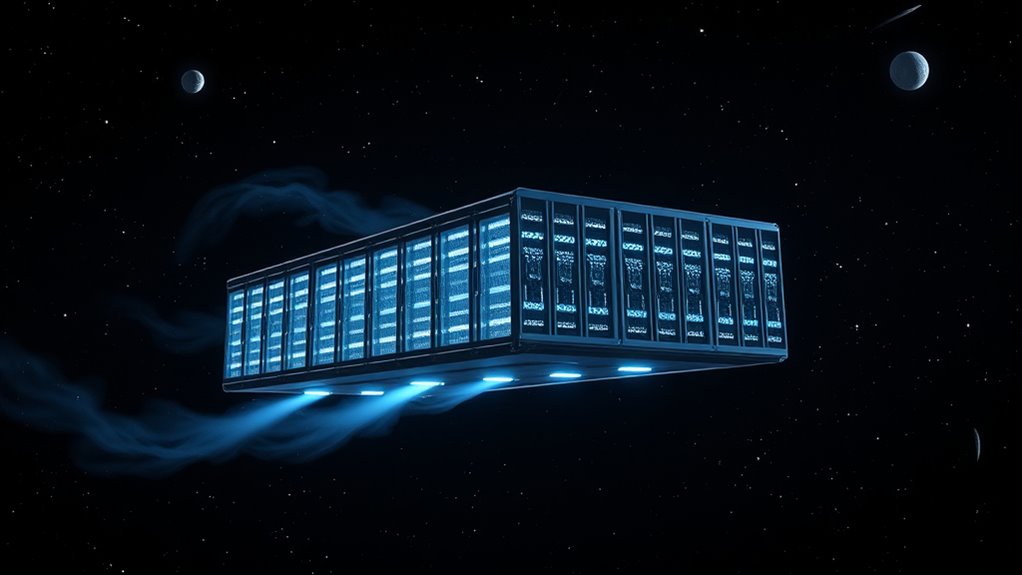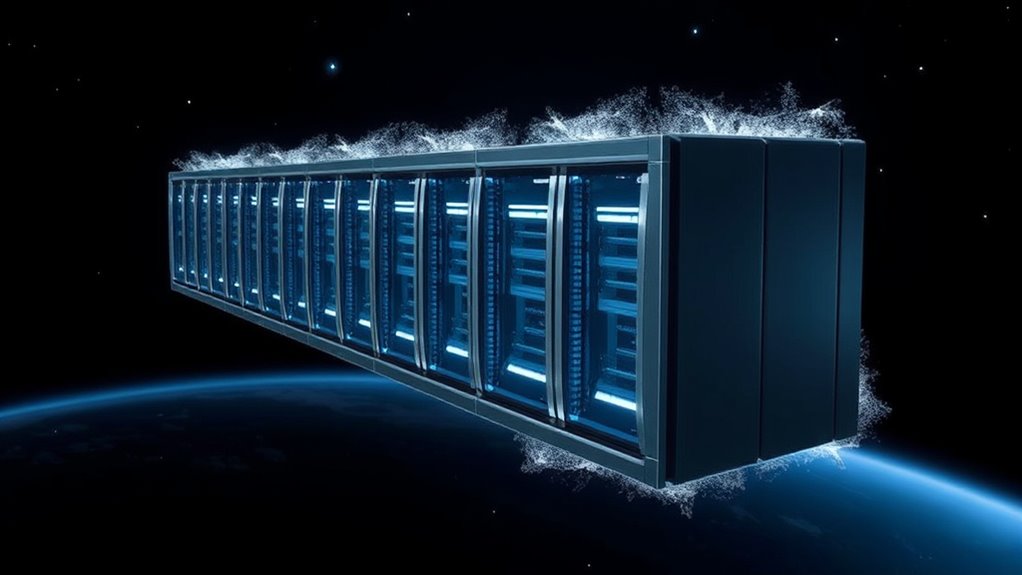Space-based data centers use the cold vacuum of space to naturally cool servers, eliminating traditional energy-intensive cooling systems. By placing servers in orbit, you benefit from rapid heat dissipation and reduced operational costs, making data management more sustainable. This innovative approach enhances efficiency and scalability while lowering environmental impact. If you want to discover how this technology transforms digital infrastructure and what challenges it faces, there’s more to explore beyond this summary.
Key Takeaways
- Space-based data centers utilize the cold vacuum of space for natural cooling of servers.
- The vacuum environment efficiently dissipates heat, reducing the need for energy-intensive cooling systems.
- Space cooling enhances energy efficiency and lowers operational costs for data storage facilities.
- Extraterrestrial infrastructure is designed to withstand space conditions, ensuring hardware longevity.
- Autonomous maintenance and advanced robotics support the operation of servers in the space environment.

Have you ever wondered if the future of data storage could be beyond Earth? The idea of space-based data centers isn’t just science fiction anymore; it’s a growing reality driven by innovations in orbital logistics and extraterrestrial infrastructure. Imagine placing servers in orbit, where the cold vacuum of space naturally cools hardware without the need for traditional cooling systems. This approach could revolutionize how we handle the ever-increasing demand for data processing and storage. By leveraging the unique environment of space, you can eliminate many of the energy-intensive cooling methods used on Earth, making data centers more sustainable and efficient.
Imagine space-based data centers cooled naturally by the vacuum of space, transforming data storage into a more sustainable future.
The challenge lies in establishing a reliable extraterrestrial infrastructure capable of supporting these data centers. Orbital logistics becomes essential here—resupplying, maintaining, and upgrading servers in orbit requires sophisticated supply chains and autonomous systems. You’d need spacecraft capable of transporting equipment and resources back and forth from Earth, while also ensuring the safe operation of the data centers in the harsh environment of space. Building this infrastructure demands careful planning, including deploying satellite networks for communication and navigation, and creating modular, scalable platforms that can adapt to future technological advancements. Additionally, space environment factors such as radiation and temperature fluctuations must be carefully managed to protect sensitive hardware.
One of the biggest advantages of space-based data centers is their natural cooling system. The vacuum of space offers an environment where heat dissipates rapidly, reducing the need for complex cooling systems that consume massive amounts of energy on Earth. This not only cuts operational costs but also markedly lowers the carbon footprint associated with data storage. Plus, with fewer physical constraints and the ability to expand into new orbital zones, you can scale capacity more flexibly than traditional centers. The potential for deploying multiple interconnected facilities in various orbits opens up new avenues for data redundancy, security, and global coverage.
Of course, establishing extraterrestrial infrastructure isn’t without its hurdles. You must contend with radiation, the vacuum environment, and the challenges of maintaining hardware remotely. Yet, advances in robotics and AI are making autonomous maintenance feasible, reducing the need for constant human intervention. As you develop these technologies, the logistics of operating space-based data centers will become more streamlined, making this concept more practical and appealing. With ongoing innovations, space-based data centers could become indispensable components of our digital future, providing a resilient, energy-efficient way to store and process data while harnessing the natural cooling power of space.
Frequently Asked Questions
How Is Power Supplied to Space-Based Data Centers?
You might wonder how power gets to space-based data centers. Typically, orbital power is harnessed through space energy sources like solar panels that convert sunlight into electricity. These panels are positioned on the data centers or nearby satellites, providing a continuous energy supply. This method guarantees a stable power source, avoiding Earth’s weather and day-night cycles, making space-based data centers efficient and reliable for your data storage needs.
What Are the Security Measures for Orbital Data Centers?
You should prioritize orbital security by implementing advanced encryption and access controls for these data centers. To protect against space debris and potential cyber threats, use real-time tracking and debris avoidance systems, along with secure communication channels. Regularly monitor orbital paths and update security protocols to mitigate risks. These measures guarantee your data remains safe, even amid the challenges posed by space debris and the complexities of maintaining secure orbital operations.
How Is Data Transmission Managed in Space?
You manage data transmission in space by utilizing advanced interstellar communication systems and quantum data links. These technologies enable secure, high-speed data transfer over vast distances, often with minimal latency. You rely on laser-based communication and quantum encryption to guarantee data integrity and security. By implementing these methods, you assure reliable connectivity between space-based servers and ground stations, supporting seamless operations across the cosmos.
What Are the Potential Environmental Impacts of Space Data Centers?
Imagine a future where space data centers float among stars, but beware—space debris could collide with them like cosmic wrecking balls, causing chaos. Their presence might intensify atmospheric effects, possibly disrupting Earth’s climate or creating unseen pollution. You’d need to weigh these risks carefully, as space debris accumulation and environmental impacts could turn a technological marvel into a hazardous satellite graveyard, threatening both space and Earth’s delicate atmosphere.
How Cost-Effective Are Space-Based Data Centers Compared to Terrestrial Ones?
You might wonder if space-based data centers are cost-effective compared to terrestrial ones. While they can reduce cooling costs by utilizing the cold vacuum of space, you’ll need to contemplate expenses like space debris mitigation and orbital maintenance. These factors add to the overall costs, potentially offsetting savings. So, their cost-effectiveness depends on balancing these challenges against the benefits of improved cooling and energy efficiency.
Conclusion
Imagine your data soaring through the cosmos, cooled by the icy vacuum of space like a comet streaking through a frozen night. Space-based data centers turn the universe into your personal cooling system, turning the harsh vacuum into a guardian of efficiency. As you embrace this stellar innovation, you’re harnessing the universe’s natural chill, transforming the way data breathes and thrives beyond Earth’s bounds—truly a cosmic leap into the future of technology.









